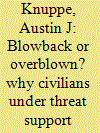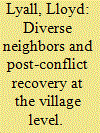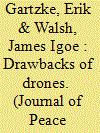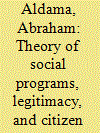|
|
|
Sort Order |
|
|
|
Items / Page
|
|
|
|
|
|
|
| Srl | Item |
| 1 |
ID:
186861


|
|
|
|
|
| Summary/Abstract |
How do military tactics shape civilian support for foreign intervention? Critics contend that invasive tactics undermine popular support by alienating the civilian population. Counterexamples suggest that civilians will support invasive tactics when foreign counterinsurgents are willing and able to mitigate a proximate threat. I reconcile these divergent findings by arguing that civilian support is a function of threat perception based on three interacting heuristics: social identity, combatant targeting, and territorial control. To evaluate my theory, I enumerate a survey among Iraqi residents in Baghdad during the anti-ISIS campaign. Respondents preferred more invasive tactics when foreign counterinsurgents assisted the most effective local members of the anti-ISIS coalition. Across sectarian divides, however, respondents uniformly opposed the deployment of foreign troops. These findings suggest that in regime-controlled communities, civilians will support counterinsurgents who are invasive enough to mitigate insurgent threats, but not too invasive as to undermine local autonomy.
|
|
|
|
|
|
|
|
|
|
|
|
|
|
|
|
| 2 |
ID:
186863


|
|
|
|
|
| Summary/Abstract |
The ability to finance conflict likely affects the odds of sustaining a war and succeeding in it. Recent literature explores rebel group funding, but far less is known about how states finance their own war efforts. This article posits that the design of central banks should affect civil war termination. In particular, it argues that central bank independence affects civil war termination through two channels. First, financial markets consider central bank independence as a good signal in terms of macroeconomic stability and debt repayment. In this way, independent central banks enhance the ability of the government to access credit to finance and end a civil war. Second, central bank independence is associated with lower inflation. Inflation control reduces one source of additional grievances that the civil war may impose on citizens. On a sample of civil wars between 1975 and 2009, central bank independence is associated with a substantial increase in the likelihood of war termination. When the form of termination is disaggregated, (higher) central bank independence is associated with a higher probability of government victory, relative to continued conflict and to other outcomes. Additional tests provide support for the argued mechanisms: during civil wars, countries with more independent central banks access international credit markets in better conditions – i.e. they pay lower interest rates, and receive longer grace and maturity periods on new debt. Furthermore, in countries experiencing civil wars, central bank independence is associated with lower inflation.
|
|
|
|
|
|
|
|
|
|
|
|
|
|
|
|
| 3 |
ID:
186867


|
|
|
|
|
| Summary/Abstract |
Countries transitioning from autocracy to democracy often struggle to maintain law and order. Yet relatively little is known about how increasing crime rates impact public support for authoritarian leadership during a transition. We find an empirical relationship between rising crime and support for authoritarian leadership in Egypt following the 2011 uprisings. Analysis of original crime data from Egypt suggests that electoral districts exposed to larger year-on-year changes in localized patterns of crime were more likely to vote for the ‘strongman’ candidate in Egypt’s first, and only, free and fair presidential election in 2012. We also analyze survey data which shows that Egyptians who were highly concerned about crime were more likely to express support for a ‘strong leader’ as well as for military rule, even after controlling for a broad set of covariates. This research illustrates how instability triggered by political transitions can have negative implications for democratic consolidation.
|
|
|
|
|
|
|
|
|
|
|
|
|
|
|
|
| 4 |
ID:
186865


|
|
|
|
|
| Summary/Abstract |
Why do some towns recover faster than others after intrastate conflict? Many important decisions about post-conflict recovery are made at the substate level, but little empirical work has investigated what causes differences in recovery outcomes within a country. This article suggests that proximity to ethno-religiously diverse neighbors slows a town’s post-conflict recovery. A town has ‘diverse neighbors’ if towns with different plurality ethno-religious groups are nearby. This hypothesis is tested by exploring variation in recovery speed among Iraqi towns after the 2014–17 Islamic State insurgency (ISIL). The article constructs 81-month panels of economic activity for 379 Iraqi settlements occupied by ISIL by using satellite-observed nighttime light emissions as a proxy for economic activity. The panels reveal large variation in post-conflict recovery among towns during the first year of peace. Village-level survey data are then used to construct a measure of neighbor diversity, which is combined with lighting-based recovery scores in spatial autoregression. The results show that greater neighbor diversity is robustly associated with slower settlement recovery. The neighbor diversity penalty cannot be fully explained by cleavages between groups ‘on opposite sides’ of the conflict; proximity to out-group neighbors appears to slow recovery even between wartime allies. Several explanations are considered, and this article suggests that the types of post-liberation controllers that arise in diverse areas – which tend to be substate militias rather than the government – may be one important mechanism.
|
|
|
|
|
|
|
|
|
|
|
|
|
|
|
|
| 5 |
ID:
186860


|
|
|
|
|
| Summary/Abstract |
Growing reliance on Unmanned Aerial Vehicles (UAVs) in the effort to combat militant groups has led to considerable debate about the consequences of this new mode of warfare. While critics have focused on the impact of civilian casualties on militant recruitment and the resulting use of terrorism, evidence suggests that ‘drones’ are paradoxically more effective in limiting civilian deaths compared to other forms of military force. This article demonstrates a different causal pathway connecting militant use of force to terrorist attacks. Drone strikes encourage militants to displace operations to urban centers. Confronted with unfamiliar terrain and greater government capacity, militants emphasize terrorist attacks against civilians. The article explores these dynamics in the longest running drone campaign, in Pakistan. While civilian casualties from drone strikes have no discernible effect on terrorism, strikes that kill militants increase terrorist attacks against civilians in urban settings, while failing to reduce attacks on government targets.
|
|
|
|
|
|
|
|
|
|
|
|
|
|
|
|
| 6 |
ID:
186866


|
|
|
|
|
| Summary/Abstract |
Why, when, and where do participants in civil wars engage in intentional cultural destruction (ICD)? Focusing on the case of ISIS in Syria, our article examines how ideological and strategic considerations intersect to shape ICD campaigns. We propose that ideologically motivated combatants rely on ICD as a form of collective violence aimed at reinforcing territorial control, and hypothesize that ICD events are most likely in areas where a group is actively contesting territory. Using an original dataset that combines data on ICD events in Syria with measures of combatant control, we conduct a quantitative analysis of the main factors contributing to the incidence of ISIS-inflicted ICD across Syria’s governorates and over time. We rely on panel regressions to assess the importance of territorial control relative to other prominent factors contributing to ICD, such as the presence of internationally recognized cultural sites and the share of ethno-religious minorities. We find that the dynamics of combatant control play a central role in accounting for the distribution of ISIS-inflicted ICD events in Syria.
|
|
|
|
|
|
|
|
|
|
|
|
|
|
|
|
| 7 |
ID:
186868


|
|
|
|
|
| Summary/Abstract |
This article reports on trends in organized violence, building on new data by the Uppsala Conflict Data Program (UCDP). The falling trend in fatalities stemming from organized violence in the world, observed between 2014 and 2019, was decisively reversed in 2021 as fatalities increased significantly. UCDP registered more than 119,100 deaths in organized violence in 2021, a 46% increase from the previous year. The increase was largely driven by escalating conflicts in Afghanistan, Ethiopia, and Yemen. Fatalities increased in all three categories of organized violence, despite a decrease in the number of active state-based conflicts, as well as the number of actors carrying out one-sided violence against civilians. UCDP recorded 54 state-based conflicts in 2021, a decrease by two compared to the previous year. Five of the conflicts were active at the intensity of war, the lowest number of wars since 2010. Violence in 2021 was thus concentrated to fewer but bloodier conflicts. Unmanned aerial vehicles (UAVs), commonly known as drones, have become increasingly important features of modern conflicts, and the trend in their usage is discussed in the special feature section. UAV usage has since 2019 dispersed among a significant larger number of actors, even as the downscaling in the involvement of the United States in the war on terror has led to a decrease in drone-related fatalities.
|
|
|
|
|
|
|
|
|
|
|
|
|
|
|
|
| 8 |
ID:
186869


|
|
|
|
|
| Summary/Abstract |
Scholars increasingly call for documentation and analysis of specific forms of conflict-related sexual violence. Moreover, accountability for crimes is stronger when specific patterns of victimization are documented. This article introduces the Repertoires of Sexual Violence in Armed Conflict (RSVAC) data package, which assembles reports from 1989 to 2015 of forms of sexual violence by government/states forces, insurgent/rebel organizations, and pro-government militias for each conflict and year. RSVAC compiles the reported prevalence of eight forms of sexual violence – rape, sexual slavery and forced marriage, forced prostitution, sexual mutilation, forced pregnancy, forced sterilization and abortion, non-penetrative sexual torture, and sexual abuse (as well as that of multiple-perpetrator reports of each form). It includes extensive qualitative notes on reported incidents, as well as ‘conflict manuscripts’ that include the relevant portions of source documents. Disaggregating ‘sexual violence’ into its distinct forms enables analysis of the reported presence of forms of sexual violence across time, conflicts, and organizations. We illustrate its usefulness by highlighting hitherto neglected global patterns it suggests, and also discuss limitations, potential biases and underreporting that users need to take into account. We outline several research questions that the data can help answer and suggest how the data package could inform policy efforts to address sexual violence and its consequences.
|
|
|
|
|
|
|
|
|
|
|
|
|
|
|
|
| 9 |
ID:
186862


|
|
|
|
|
| Summary/Abstract |
Aid and social programs are commonly used to fight insurgencies. However, sometimes they fail to achieve their goal of increasing citizen cooperation with the state. I propose a series of game-theoretic models that focus on the strategic interaction between a state and a citizen in the face of a challenge to the state’s monopoly of power by an insurgency. I argue that even if the provision of aid or social programs increases citizens’ intrinsic motivation to cooperate with the state, it does not necessarily translate into more cooperation. I show that citizen cooperation depends on whether the increase in the provision of aid is accompanied by an increase in the use of violent or hard tools by the state, the citizens’ expectation of future rewards, and the insurgency’s response. The models thus provide a rationale for why even if social programs increase state legitimacy, they may fail to increase citizen cooperation.
|
|
|
|
|
|
|
|
|
|
|
|
|
|
|
|
| 10 |
ID:
186864


|
|
|
|
|
| Summary/Abstract |
Lijphart’s claim that power-sharing spurs democratization in divided societies has strongly influenced ‘institutional engineering’ and is widely accepted among scholars despite the fact that empirical tests of its merits remain rare. This article revisits the democratic effect of power-sharing, arguing that it has two antagonist faces. On the positive side, it provides guarantees of inclusion to political elites, allowing them to commit to democratic rules. On the negative side, it also has an illiberal face, entailing limits on competition and individual rights. In this article, these contrary characteristics are traced back to two institutional types of power-sharing: a more flexible and open, liberal, type and a more rigid, corporate one. Using a novel dataset on power-sharing rules for 138 multi-ethnic countries and the period from 1945 to 2016, their respective democratic merits are tested. Conforming to theoretical expectations, the findings indicate that only liberal forms of power-sharing exhibit strong positive effects on democracy while corporate forms exert mixed or even negative ones. These findings are robust to a series of alternate model specifications and operationalizations as well as to instrumental variable approaches. In conclusion, the article indicates only a partial democratic effect of power-sharing, limited to its liberal subtype.
|
|
|
|
|
|
|
|
|
|
|
|
|
|
|
|
| 11 |
ID:
186870


|
|
|
|
|
| Summary/Abstract |
In the course of civil war, it is not unusual for armed rebels, who are fighting to either take control of a state or create a new one, to create state-like governing institutions. For example, nearly 64% of rebels between 1945 and 2012 created at least one governing institution. One challenge to moving the literature on rebel governance forward is getting data on the many possible institutions that comprise rebel governance. I introduce new data, the Rebel Quasi-State Institutions dataset, which covers 235 rebel groups and codes annually for 25 institutions during the entire existence of the group. I demonstrate the usefulness of this new dataset by exploring a relationship important to scholars: that of rebel strength and rebel governance institutions (Stewart, 2020). These analyses show two things. First, there is value in disaggregating rebel governance and looking at institutions separately because not all governance institutions are correlated with strength in the same direction. Second, taking into account the time dimension is important. Since rebel conventional capability increased as a result of the end of the Cold War (Kalyvas & Balcells, 2010) and rebel institutions became more prevalent, there is an important time component to rebel governance that correlates with events in the international system.
|
|
|
|
|
|
|
|
|
|
|
|
|
|
|
|
|
|
|
|
|